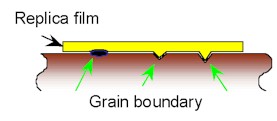Field metallography begins with the very rough grinding of the
selected area, usually with a 60 grit abrasive. The beginning surface is
often in a much poorer state than any surface found in the lab. Thick
scale and rust must be removed in an area larger than the ultimate spot.
Each area worked should be smaller than that worked in the previous
step. This reduces the opportunity of dragging large particles across a
prepared area.
After rough grinding, several fine grinding steps occur. Fine
grinding is performed with abrasives in the 120 through 600 mesh range.
As with metallography performed in the lab, each abrasive step should
remove the surface deformation produced by the previous step.
The next step is polishing of the surface. Like lab work, this is
done with polishing cloths and compounds. Because of the importance of
turn around time frequently found on field metallography work sites,
diamond compounds are preferred over other slower working products.
Again, each polishing step should remove the scratches and deformation
of the previous step.
Pro per
enchant use after polishing is usually required to bring out
the relevant microstructure.
per
enchant use after polishing is usually required to bring out
the relevant microstructure.
Analysis and documentation are the final steps in field metallography.
A portable microscope is used for the field analysis, but complete
documentation and laboratory analysis can be achieved with cellulose
acetate tape with a replication technique. Prepared properly and secured
in the field with glass slides, field replicas can be analyzed with
SEM
magnifications with very good results.
Advantage of
Replication



